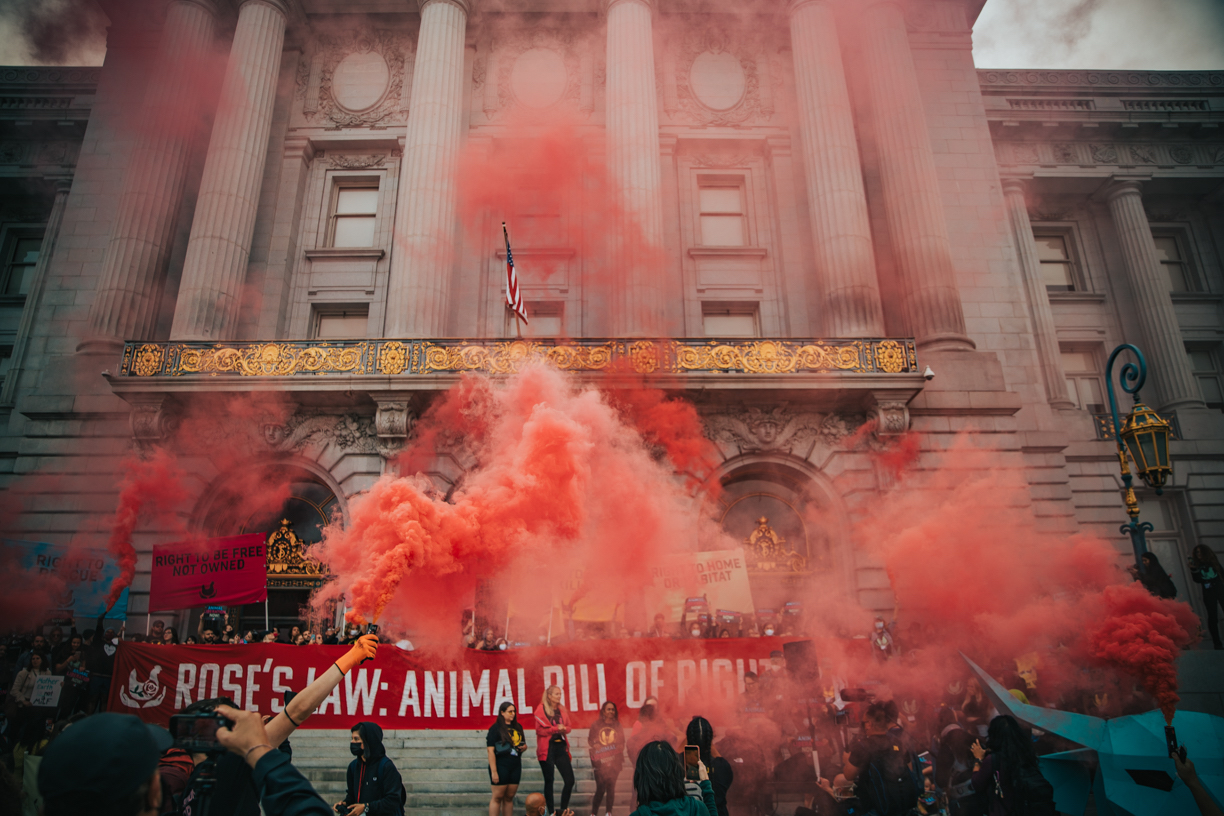Gateways

I previously blogged about a shift in ideological composition in the animal rights movement, away from single issue campaigns, such as vivisection and fur, and toward animal agriculture and anti-speciesism. A number of groups and thinkers have quite compellingly argued for this shift – in part because the most aggressive single issue campaigns, e.g. anti-vivisection in the UK, have failed to cause any real or permanent changes in the tide of animal exploitation. And the shift is beginning to take hold. For example, Effective Animal Activism, an extremely smart non-profit and community space founded by my friend Eitan (a Stanford law and philosophy Ph.D. student), now routinely recommends organizations and tactics that focus on farmed animals over more narrow campaigns.
Direct Action Everywhere is part of this change in ideology and messaging – all of our tactics have an expressly anti-speciesist message, with the goal of challenging (rather than accommodating) traditional views on the use and inferiority of non-human animals.
And yet, we also participate in many campaigns that might be described as “single issue.” This weekend, for example, DxE was part of the coalition that organized the March for Elephants. We also organized a solidarity demonstration with a Russian campaign to end the slaughter of stray dogs and cats. (See here for details on both actions.) Why do we do such campaigns, when there are literally billions more animals suffering in food production? And how do we respond to critics who say that we are wasting our time?
In a word: gateways. These campaigns offer us a gateway into:
- the moral intuitions of ordinary people;
- political coalitions that are larger than our own; and
- media channels that would otherwise ignore our message.
Moral Metaphors. The first and most important reason is that these campaigns have metaphorical value. Most human beings have trouble empathizing, for example, with a chicken or fish. (As one scholar put it, “mpathy is more pronounced the closer the relationship between individuals. Indeed, empathy and degree of closeness are correlated such that the magnitude of the response follows a pattern of kin > close friends > acquaintances > strangers.”) In contrast, companion animals, and charismatic megafauna such as elephants, can serve as powerful, empathy-triggering metaphors for the broader issue of animal liberation.
Political Coalitions. Campaigns and movements for certain species have larger coalitions than what we currently have for anti-speciesism. True, these coaliations are often also more shallow; in particular, they demand less of their adherents, in both behavioral and political change. And they often target foreign peoples and practices, rather than our own behavior. And yet, they cannot be ignored. As one illustrative example, the Elephants March in San Francisco probably had at least twice as many people than the Earthlings March. That difference in numbers cannot be ignored; numbers matter for the effectiveness of protest.
Message Amplification. The third and final reason to participate in “narrow” campaigns is that they allow us to amplify our message, and reach different social networks, through both mainstream and social media. The content of the mainstream media, for example, probably responds to consumer preferences. And so if we want our message to reach the media, we have to demonstrate that it has value to the ordinary person. One way to do so is to use gateway animals for whom there is already powerful public sentiment to protect. Americans spend billions of dollars caring for their companion animals; they spend billions more on charismatic endangered species. In contrast, even the largest animal rights groups have a few million dollars. To tap the animal rights message into the broader media presence, it sometimes makes sense to shift the examples we use (though not, as I argue below, our ultimate focus).
…or Black Holes? In all three of these areas, however, maintaining a strong and uncompromising message of animal liberation is vital. Otherwise, the gateway may turn into a black hole!
To take advantage of the powerful moral metaphor between dogs and, say, pigs, we can’t be afraid to challenge traditional species distinctions, and ask, “Yes, you love dogs. But, really, what makes a dog so different from a chicken, pig, or cow?”
If the expansion into a political coalition comes at the cost of message integrity, the rationale behind the coalition has been undermined. Indeed, you might have weakened your movement because expansion into the coalition may well erode adherents from your own message: “Gee, look how much more success they are having with this single issue. Why should I keep working for animal liberation, when even the animal advocates aren’t concerned about it?”
And if the message amplified, by focus on a more “narrow” and less challenging issue, is one that does not even touch on the broader concerns of speciesism and human supremacy, then the opportunity presented by media attention has been wasted.
But if we can avoid these pitfalls -- if we can use particular species as gateways, rather than losing our message in them, as black holes -- seemingly single-issue campaigns can provide immense benefits. (They are also the only way to maintain victories on the single issue. The rebounding fur and vivisection industries are wonderful examples of how temporary victories, against a particular company or even industry, are impossible to maintain if the broader culture remains blatantly speciesist.) We just have to be strategic, smart, and above all, focused on the underlying message: total animal liberation.
Other articles

Tulare County Dairy Farms Are Poisoning Latino Communities

The Case for Systemic Change




